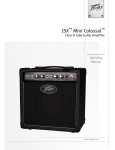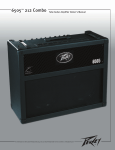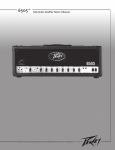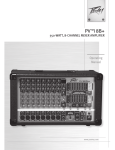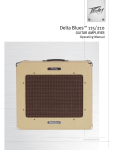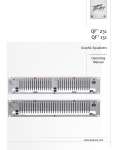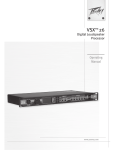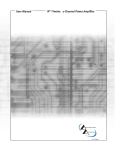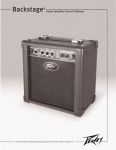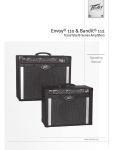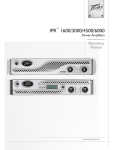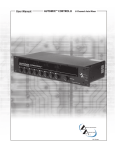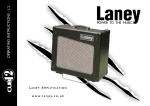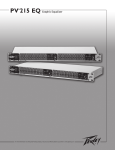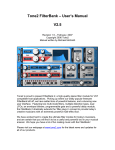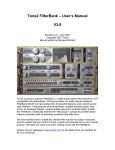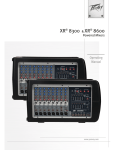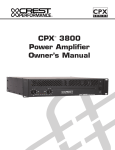Download Peavey Electronics Stereo System VSX 48 User's Manual
Transcript
VSX™ 48
Digital Loudspeaker
Processor
Operating
Manual
www.peavey.com
Intended to alert the user to the presence of uninsulated “dangerous voltage” within the product’s
enclosure that may be of sufficient magnitude to constitute a risk of electric shock to persons.
Intended to alert the user of the presence of important operating and maintenance (servicing)
instructions in the literature accompanying the product.
CAUTION: Risk of electrical shock — DO NOT OPEN!
CAUTION: To reduce the risk of electric shock, do not remove cover. No user serviceable parts
inside. Refer servicing to qualified service personnel.
WARNING: To prevent electrical shock or fire hazard, this apparatus should not be exposed to rain
or moisture‚ and objects filled with liquids‚ such as vases‚ should not be placed on this apparatus.
Before using this apparatus‚ read the operating guide for further warnings.
Este símbolo tiene el propósito, de alertar al usuario de la presencia de “(voltaje) peligroso” sin
aislamiento dentro de la caja del producto y que puede tener una magnitud suficiente como para
constituir riesgo de descarga eléctrica.
Este símbolo tiene el propósito de alertar al usario de la presencia de instruccones importantes
sobre la operación y mantenimiento en la información que viene con el producto.
PRECAUCION: Riesgo de descarga eléctrica ¡NO ABRIR!
PRECAUCION: Para disminuír el riesgo de descarga eléctrica, no abra la cubierta. No hay piezas
útiles dentro. Deje todo mantenimiento en manos del personal técnico cualificado.
ADVERTENCIA: Para prevenir choque electrico o riesgo de incendios, este aparato no se debe
exponer a la lluvia o a la humedad. Los objetos llenos de liquidos, como los floreros, no se deben
colocar encima de este aparato. Antes de usar este aparato, lea la guia de funcionamiento para
otras advertencias.
Ce symbole est utilisé dans ce manuel pour indiquer à l’utilisateur la présence d’une tension
dangereuse pouvant être d’amplitude suffisante pour constituer un risque de choc électrique.
Ce symbole est utilisé dans ce manuel pour indiquer à l’utilisateur qu’il ou qu’elle trouvera
d’importantes instructions concernant l’utilisation et l’entretien de l’appareil dans le paragraphe
signalé.
ATTENTION: Risques de choc électrique — NE PAS OUVRIR!
ATTENTION: Afin de réduire le risque de choc électrique, ne pas enlever le couvercle. Il ne se
trouve à l’intérieur aucune pièce pouvant être reparée par l’utilisateur. Confiez I’entretien et la
réparation de l’appareil à un réparateur Peavey agréé.
AVIS: Dans le but de reduire les risques d’incendie ou de decharge electrique, cet appareil ne
doit pas etre expose a la pluie ou a l’humidite et aucun objet rempli de liquide, tel qu’un vase, ne
doit etre pose sur celui-ci. Avant d’utiliser de cet appareil, lisez attentivement le guide fonctionnant
pour avertissements supplémentaires.
Dieses Symbol soll den Anwender vor unisolierten gefährlichen Spannungen innerhalb des
Gehäuses warnen, die von Ausreichender Stärke sind, um einen elektrischen Schlag verursachen
zu können.
Dieses Symbol soll den Benutzer auf wichtige Instruktionen in der Bedienungsanleitung
aufmerksam machen, die Handhabung und Wartung des Produkts betreffen.
VORSICHT: Risiko — Elektrischer Schlag! Nicht öffnen!
VORSICHT: Um das Risiko eines elektrischen Schlages zu vermeiden, nicht die Abdeckung
enfernen. Es befinden sich keine Teile darin, die vom Anwender repariert werden könnten.
Reparaturen nur von qualifiziertem Fachpersonal durchführen lassen.
WARNUNG: Um elektrischen Schlag oder Brandgefahr zu verhindern, sollte dieser Apparat nicht
Regen oder Feuchtigkeit ausgesetzt werden und Gegenstände mit Flüssigkeiten gefuellt, wie
Vasen, nicht auf diesen Apparat gesetzt werden. Bevor dieser Apparat verwendet wird, lesen Sie
bitte den Funktionsführer für weitere Warnungen.
2
IMPORTANT SAFETY INSTRUCTIONS
WARNING: When using electrical products, basic cautions should always be followed, including the following:
1.
2.
3.
4.
5.
6.
7.
8.
9.
10.
11.
12.
13.
14.
15.
16.
17.
18.
19.
Read these instructions.
Keep these instructions.
Heed all warnings.
Follow all instructions.
Do not use this apparatus near water.
Clean only with a dry cloth.
Do not block any of the ventilation openings. Install in accordance with manufacturer’s instructions.
Do not install near any heat sources such as radiators, heat registers, stoves or other apparatus (including
amplifiers) that produce heat.
Do not defeat the safety purpose of the polarized or grounding-type plug. A polarized plug has two blades with
one wider than the other. A grounding type plug has two blades and a third grounding plug. The wide blade or
third prong is provided for your safety. If the provided plug does not fit into your outlet, consult an electrician for
replacement of the obsolete outlet.
Protect the power cord from being walked on or pinched, particularly at plugs, convenience receptacles, and the
point they exit from the apparatus.
Only use attachments/accessories provided by the manufacturer.
Use only with a cart, stand, tripod, bracket, or table specified by the manufacturer, or sold with the apparatus.
When a cart is used, use caution when moving the cart/apparatus combination to avoid injury from tip-over.
Unplug this apparatus during lightning storms or when unused for long periods of time.
Refer all servicing to qualified service personnel. Servicing is required when the apparatus has been damaged
in any way, such as power-supply cord or plug is damaged, liquid has been spilled or objects have fallen into the
apparatus, the apparatus has been exposed to rain or moisture, does not operate normally, or has been dropped.
Never break off the ground pin. Write for our free booklet “Shock Hazard and Grounding.” Connect only to a
power supply of the type marked on the unit adjacent to the power supply cord.
If this product is to be mounted in an equipment rack, rear support should be provided.
Note for UK only: If the colors of the wires in the mains lead of this unit do not correspond with the terminals in
your plug‚ proceed as follows:
a) The wire that is colored green and yellow must be connected to the terminal that is marked by the letter E‚ the
earth symbol‚ colored green or colored green and yellow.
b) The wire that is colored blue must be connected to the terminal that is marked with the letter N or the color
black.
c) The wire that is colored brown must be connected to the terminal that is marked with the letter L or the color
red.
This electrical apparatus should not be exposed to dripping or splashing and care should be taken not to place
objects containing liquids, such as vases, upon the apparatus.
Exposure to extremely high noise levels may cause a permanent hearing loss. Individuals vary considerably in
susceptibility to noise-induced hearing loss, but nearly everyone will lose some hearing if exposed to sufficiently
intense noise for a sufficient time. The U.S. Government’s Occupational Safety and Health Administration (OSHA)
has specified the following permissible noise level exposures:
Duration Per Day In Hours
8
6
4
3
2
1 1⁄2
1
1⁄2
1⁄4 or less
Sound Level dBA, Slow Response
90
92
95
97
100
102
105
110
115
According to OSHA, any exposure in excess of the above permissible limits could result in some hearing loss. Ear plugs or protectors
to the ear canals or over the ears must be worn when operating this amplification system in order to prevent a permanent hearing
loss, if exposure is in excess of the limits as set forth above. To ensure against potentially dangerous exposure to high sound
pressure levels, it is recommended that all persons exposed to equipment capable of producing high sound pressure levels such as
this amplification system be protected by hearing protectors while this unit is in operation.
SAVE THESE INSTRUCTIONS!
3
WICHTIGE SICHERHEITSHINWEISE
ACHTUNG: Beim Einsatz von Elektrogeräten müssen u.a. grundlegende Vorsichtsmaßnahmen befolgt werden:
1.
Lesen Sie sich diese Anweisungen durch.
2.
Bewahren Sie diese Anweisungen auf.
3.
Beachten Sie alle Warnungen.
4.
Befolgen Sie alle Anweisungen.
5.
Setzen Sie dieses Gerät nicht in der Nähe von Wasser ein.
6.
Reinigen Sie es nur mit einem trockenen Tuch.
7.
Blockieren Sie keine der Lüftungsöffnungen. Führen Sie die Installation gemäß den Anweisungen des Herstellers durch.
8.
Installieren Sie das Gerät nicht neben Wärmequellen wie Heizungen, Heizgeräten, Öfen oder anderen Geräten (auch
Verstärkern), die Wärme erzeugen.
9.
Beeinträchtigen Sie nicht die Sicherheitswirkung des gepolten Steckers bzw. des Erdungssteckers. Ein gepolter Stecker
weist zwei Stifte auf, von denen einer breiter ist als der andere. Ein Erdungsstecker weist zwei Stifte und einen dritten
Erdungsstift auf. Der breite Stift bzw. der dritte Stift dient Ihrer Sicherheit. Sollte der beiliegende Stecker nicht in Ihre
Steckdose passen, wenden Sie sich bitte an einen Elektriker, um die ungeeignete Steckdose austauschen zu lassen.
10.
Schützen Sie das Netzkabel, sodass niemand darauf tritt oder es geknickt wird, insbesondere an Steckern oder Buchsen
und ihren Austrittsstellen aus dem Gerät.
11.
Verwenden Sie nur die vom Hersteller erhältlichen Zubehörgeräte oder Zubehörteile.
12.
Verwenden Sie nur einen Wagen, Stativ, Dreifuß, Träger oder Tisch, der den Angaben des Herstellers entspricht oder
zusammen mit dem Gerät verkauft wurde. Wird ein Wagen verwendet, bewegen Sie den Wagen mit dem darauf
befindlichen Gerät besonders vorsichtig, damit er nicht umkippt und möglicherweise jemand verletzt wird.
13.
Trennen Sie das Gerät während eines Gewitters oder während längerer Zeiträume, in denen es nicht benutzt wird, von
der Stromversorgung.
14.
Lassen Sie sämtliche Wartungsarbeiten von qualifizierten Kundendiensttechnikern durchführen. Eine Wartung ist
erforderlich, wenn das Gerät in irgendeiner Art beschädigt wurde, etwa wenn das Netzkabel oder der Netzstecker
beschädigt wurden, Flüssigkeit oder Gegenstände in das Gerät gelangt sind, das Gerät Regen oder Feuchtigkeit
ausgesetzt wurde, nicht normal arbeitet oder heruntergefallen ist.
15.
Der Erdungsstift darf nie entfernt werden. Auf Wunsch senden wir Ihnen gerne unsere kostenlose Broschüre „Shock
Hazard and Grounding“ (Gefahr durch elektrischen Schlag und Erdung) zu. Schließen Sie nur an die Stromversorgung der
Art an, die am Gerät neben dem Netzkabel angegeben ist.
16.
Wenn dieses Produkt in ein Geräte-Rack eingebaut werden soll, muss eine Versorgung über die Rückseite eingerichtet
werden.
17.
Hinweis – Nur für Großbritannien: Sollte die Farbe der Drähte in der Netzleitung dieses Geräts nicht mit den Klemmen in
Ihrem Stecker übereinstimmen, gehen Sie folgendermaßen vor:
a) Der grün-gelbe Draht muss an die mit E (Symbol für Erde) markierte bzw. grüne oder grün-gelbe Klemme
angeschlossen werden.
b) Der blaue Draht muss an die mit N markierte bzw. schwarze Klemme angeschlossen werden.
c) Der braune Draht muss an die mit L markierte bzw. rote Klemme angeschlossen werden.
18.
Dieses Gerät darf nicht ungeschützt Wassertropfen und Wasserspritzern ausgesetzt werden und es muss darauf geachtet
werden, dass keine mit Flüssigkeiten gefüllte Gegenstände, wie z. B. Blumenvasen, auf dem Gerät abgestellt werden.
19.
Belastung durch extrem hohe Lärmpegel kann zu dauerhaftem Gehörverlust führen. Die Anfälligkeit für durch Lärm
bedingten Gehörverlust ist von Mensch zu Mensch verschieden, das Gehör wird jedoch bei jedem in gewissem Maße
geschädigt, der über einen bestimmten Zeitraum ausreichend starkem Lärm ausgesetzt ist. Die US-Arbeitsschutzbehörde
(Occupational and Health Administration, OSHA) hat die folgenden zulässigen Pegel für Lärmbelastung festgelegt:
Dauer pro Tag in Stunden
Geräuschpegel dBA, langsame Reaktion
8
6
4
3
2
1 1⁄2
1
1
⁄2
1
⁄4 oder weniger
90
92
95
97
100
102
105
110
115
Laut OSHA kann jede Belastung über den obenstehenden zulässigen Grenzwerten zu einem gewissen Gehörverlust führen. Sollte
die Belastung die obenstehenden Grenzwerte übersteigen, müssen beim Betrieb dieses Verstärkungssystems Ohrenstopfen oder
Schutzvorrichtungen im Gehörgang oder über den Ohren getragen werden, um einen dauerhaften Gehörverlust zu verhindern. Um
sich vor einer möglicherweise gefährlichen Belastung durch hohe Schalldruckpegel zu schützen, wird allen Personen empfohlen, die
mit Geräten arbeiten, die wie dieses Verstärkungssystem hohe Schalldruckpegel erzeugen können, beim Betrieb dieses Geräts einen
Gehörschutz zu tragen.
BEWAHREN SIE DIESE SICHERHEITSHINWEISE AUF!
4
INSTRUCTIONS IMPORTANTES DE SECURITE
ATTENTION: L’utilisation de tout appareil électrique doit être soumise aux precautions d’usage incluant:
1.
2. 3.
4.
5.
6.
7.
8.
9.
10.
11. 12.
13.
14.
15.
16.
17.
18.
19.
Lire ces instructions.
Gardez ce manuel pour de futures références.
Prétez attention aux messages de précautions de ce manuel.
Suivez ces instructions.
N’utilisez pas cette unité proche de plans d’eau.
N’utilisez qu’un tissu sec pour le nettoyage de votre unité.
N’obstruez pas les systèmes de refroidissement de votre unité et installez votre unité en fonction des
instructions de ce manuel.
Ne positionnez pas votre unité à proximité de toute source de chaleur.
Connectez toujours votre unité sur une alimentation munie de prise de terre utilisant le cordon d’alimentation
fourni.
Protégez les connecteurs de votre unité et positionnez les cablages pour éviter toutes déconnexions
accidentelles.
N’utilisez que des fixations approuvées par le fabriquant.
Lors de l’utilsation sur pied ou pole de support, assurez dans le cas de déplacement de l’ensemble enceinte/
support de prévenir tout basculement intempestif de celui-ci.
Il est conseillé de déconnecter du secteur votre unité en cas d’orage ou de durée prolongée sans utilisation.
Seul un technicien agréé par le fabriquant est à même de réparer/contrôler votre unité. Celle-ci doit être
contrôlée si elle a subit des dommages de manipulation, d’utilisation ou de stockage (humidité,…).
Ne déconnectez jamais la prise de terre de votre unité.
Si votre unité est destinée a etre montée en rack, des supports arriere doivent etre utilises.
Note pour les Royaumes-Unis: Si les couleurs de connecteurs du cable d’alimentation ne correspond pas au
guide de la prise secteur, procédez comme suit:
a) Le connecteur vert et jaune doit être connectrer au terminal noté E, indiquant la prise de terre ou
correspondant aux couleurs verte ou verte et jaune du guide.
b) Le connecteur Bleu doit être connectrer au terminal noté N, correspondnat à la couleur noire du guide.
c) Le connecteur marron doit être connectrer au terminal noté L, correspondant à la couleur rouge du guide.
Cet équipement électrique ne doit en aucun cas être en contact avec un quelconque liquide et aucun objet
contenant un liquide, vase ou autre ne devrait être posé sur celui-ci.
Une exposition à de hauts niveaux sonores peut conduire à des dommages de l’écoute irréversibles. La
susceptibilité au bruit varie considérablement d’un individu à l’autre, mais une large majorité de la population
expériencera une perte de l’écoute après une exposition à une forte puissance sonore pour une durée
prolongée. L’organisme de la santé américaine (OSHA) a produit le guide ci-dessous en rapport à la perte
occasionnée:
Durée par Jour (heures)
8
6
4
3
2
1 1⁄2
1
1
⁄2
1
⁄4 ou inférieur
Niveau sonore moyen (dBA)
90
92
95
97
100
102
105
110
115
D’après les études menées par le OSHA, toute exposition au delà des limites décrites ce-dessus entrainera des pertes de l’écoute
chez la plupart des sujets. Le port de système de protection (casque, oreilette de filtrage,…) doit être observé lors de l’opération cette
unité ou des dommages irréversibles peuvent être occasionnés. Le port de ces systèmes doit être observé par toutes personnes susceptibles d’être exposées à des conditions au delà des limites décrites ci-dessus.
GARDEZ CES INSTRUCTIONS!
5
INSTRUCCIONES IMPORTANTES PARA SU SEGURIDAD
CUIDADO: Cuando use productos electrónicos, debe tomar precauciones básicas, incluyendo las siguientes:
1.
Lea estas instrucciones.
2.
3.
4.
5.
6.
7.
8.
9.
10.
11.
12.
13. 14. 15. 16.
17. 18.
19.
Guarde estas instrucciones.
Haga caso de todos los consejos.
Siga todas las instrucciones.
No usar este aparato cerca del agua.
Limpiar solamente con una tela seca.
No bloquear ninguna de las salidas de ventilación. Instalar de acuerdo a las instrucciones del fabricante.
No instalar cerca de ninguna fuente de calor como radiadores, estufas, hornos u otros aparatos (incluyendo
amplificadores) que produzcan calor.
No retire la patilla protectora del enchufe polarizado o de tipo “a Tierra”. Un enchufe polarizado tiene dos puntas,
una de ellas más ancha que la otra. Un enchufe de tipo “a Tierra” tiene dos puntas y una tercera “a Tierra”. La punta
ancha (la tercera ) se proporciona para su seguridad. Si el enchufe proporcionado no encaja en su enchufe de red,
consulte a un electricista para que reemplaze su enchufe obsoleto.
Proteja el cable de alimentación para que no sea pisado o pinchado, particularmente en los enchufes, huecos, y los
puntos que salen del aparato.
Usar solamente añadidos/accesorios proporcionados por el fabricante.
Usar solamente un carro, pie, trípode, o soporte especificado por el fabricante, o vendido junto al aparato. Cuando
se use un carro, tenga cuidado al mover el conjunto carro/aparato para evitar que se dañe en un vuelco. No
suspenda esta caja de ninguna manera.
Desenchufe este aparato durante tormentas o cuando no sea usado durante largos periodos de tiempo.
Para cualquier reparación, acuda a personal de servicio cualificado. Se requieren reparaciones cuando el aparato ha
sido dañado de alguna manera, como cuando el cable de alimentación o el enchufe se han dañado, algún líquido ha
sido derramado o algún objeto ha caído dentro del aparato, el aparato ha sido expuesto a la lluvia o la humedad, no
funciona de manera normal, o ha sufrido una caída.
Nunca retire la patilla de Tierra.Escríbanos para obtener nuestro folleto gratuito “Shock Hazard and Grounding”
(“Peligro de Electrocución y Toma a Tierra”). Conecte el aparato sólo a una fuente de alimentación del tipo marcado
al lado del cable de alimentación.
Si este producto va a ser enracado con más equipo, use algún tipo de apoyo trasero.
Nota para el Reino Unido solamente: Si los colores de los cables en el enchufe principal de esta unidad no
corresponden con los terminales en su enchufe‚ proceda de la siguiente manera:
a) El cable de color verde y azul debe ser conectado al terminal que está marcado con la letra E‚ el símbolo de
Tierra (earth)‚ coloreado en verde o en verde y amarillo.
b) El cable coloreado en azul debe ser conectado al terminal que está marcado con la letra N o el color negro.
c) El cable coloreado en marrón debe ser conectado al terminal que está marcado con la letra L o el color rojo.
Este aparato eléctrico no debe ser sometido a ningún tipo de goteo o salpicadura y se debe tener cuidado para no
poner objetos que contengan líquidos, como vasos, sobre el aparato.
La exposición a altos niveles de ruido puede causar una pérdida permanente en la audición. La susceptibilidad
a la pérdida de audición provocada por el ruido varía según la persona, pero casi todo el mundo perderá algo de
audición si se expone a un nivel de ruido suficientemante intenso durante un tiempo determinado. El Departamento
para la Salud y para la Seguridad del Gobierno de los Estados Unidos (OSHA) ha especificado las siguientes
exposiciones al ruido permisibles:
Duración por Día en Horas
8
6
4
3
2
1 1⁄2
1
1
⁄2
1
⁄4 o menos
Nivel de Sonido dBA, Respuesta Lenta
90
92
95
97
100
102
105
110
115
De acuerdo al OSHA, cualquier exposición que exceda los límites arriba indicados puede producir algún tipo de pérdida en la
audición. Protectores para los canales auditivos o tapones para los oídos deben ser usados cuando se opere con este sistema de
sonido para prevenir una pérdida permanente en la audición, si la exposición excede los límites indicados más arriba. Para protegerse de una exposición a altos niveles de sonido potencialmente peligrosa, se recomienda que todas las personas expuestas a
equipamiento capaz de producir altos niveles de presión sonora, tales como este sistema de amplificación, se encuentren protegidas
por protectores auditivos mientras esta unidad esté operando.
GUARDE ESTAS INSTRUCCIONES!
6
ENGLISH
VSX™ 48
Digital Loudspeaker Processor
The VSX 48 is a fully progammable 32-bit audio processing and louspeaker management control system. Considerably
more powerful than similarly priced units, the VSX 48 provides a versatile and economical alternative for system
designers.
Please read this guide carefully to ensure your personal safety as well as the safety of your equipment.
Features
• 5 inputs/8 outputs
• 48 kHz sample rate – 24-bit 256x over-sampled Delta-Sigma AD, DA
• USB A and B ports for memory storage and computer interface
• XLR inputs and outputs
• +24 dBu inputs and outputs
• Phantom power +48V
7
Front Panel
1
2
3
5
4
5
6
Input Section
(1) MIC input
Front panel Mic or line level input. Phantom power may be selected in software. May be used as a extra
input and routed through the system.
(2) DATA WHEEL
Rotate clockwise or counter clockwise to scroll through screens. Push to enter or confirm selection.
(3) LCD DISPLAY
This screen gives a graphical representation of unit configuration and parameter settings. The layout of the
screen and the information displayed will depend on the function being monitored or set.
(4) Parameter Select Buttons
SETUP: Configurations are selected here. Parameter selection for inputs, signal generator, stereo/
mono, routing matrix, and outputs.
EQ: parameter selection of input or output equalizers
Dynamics: parameter selection of input or output compressor/limiters
Xover: parameters of the bandpass modules for each output or configured crossover
Delay: delay time and polarity for each input or output
TOOLS: saving and loading of presets as well as default configuration
(5) Input/Output Monitoring:
LEDs indicate active or muted channel conditions. Mute switches are provided to manually mute inputs
or outputs. Signal LEDs are Green for normal signal level, Yellow at +18 dBu output and Red at +20 dBu,
just before the onset of clipping.
(6) USB ports:
Connection of memory stick/jump drive for preset storage and system update. The slot supports USB 2.0
memory sticks whose current draw is 150 ma or less.
NOTE: Some USB memory sticks with proprietary software may not function correctly. Make sure the memory stick is properly formated and there are no autorun programs installed.
8
Rear Panel
1
2
3
(1) IEC power input and fuse holder
(2) Output Section
XLR male line level outputs
(3) Input section
XLR female line level inputs. Input A may be switched to AES digital input via software.
9
Setup/Configuration Screen
Rotate the data wheel to scroll across the screen and push the
wheel to select and confirm.
A B C & D INPUTS:
Input sensitivity switches between –10 dBV or +4 dBV inputs.
The +4 dB position should be considered the “normal” position
and should be used with professional systems. The -10 dB
position allows the unit to be driven with “hi-fi” level equipment or
directly from a CD player.
Mute toggle on/off.
Analog/digital operation is selectable on input A.
Level controls digital processing headroom and is adjustable from 0 dB through –100 dB. This adjustment is
best left as high as possible but may be adjusted as necessary.
Trim is variable from –6 dB to +6 dB and is used to match analog input sensitivity as necessary.
Exit this screen by selecting “Done” and pressing the data wheel or pressing the “setup” button.
ST/M:
Toggles between Stereo and Mono. Selecting Stereo associates
the A/B channel inputs. It does not affect the output channels.
When engaged in “stereo” adjusting a parameter on channel
A will make a corresponding adjustment on Ch B. This may be
most useful when adjusting PEQs, Delay or Dynamic settings.
Preliminary adjustments can be made to both channels in this
manner and then the switch can be toggled to mono allowing
further independent adjustment of single inputs. The switch
may be toggled again to link up the dynamic sections for stereo
tracking of the comp/limiters.
MIC:
Allows engaging the +48 V phantom power as well as adjusting
the Mic gain range from 23 dB to 67 dB of gain. Select “done” or
press “setup” to escape to the main screen.
GEN:
This screen selects the parameters for the signal generator.
Pink, White or Sine may be selected. When Sine is selected the
frequency of the sine wave may be adjusted for 20 Hz to 20 kHz.
The output level may be adjusted by highlighting the fader graphic
and adjusting the Level control. An In/Out button is provided
to turn on and off the generator. The screen may be exited by
selecting “done” or pressing the “setup button. The Generator
must be assigned to an output of your choice with the Matrix. A
single Band pass filter can also be assigned to that output and
the skirts may be adjusted to provide limited bandwidth noise for
testing purposes.
Matrix:
The matrix provides the method to assign inputs to outputs. In
the default configuration NO SIGNAL IS PASSED through the
unit until some selection in the matrix is made. This prevents
potentially destructive signals from reaching the wrong outputs.
The inputs are represented by the rows and the outputs by
the columns. Most users will commonly assign crossovers in
the setup screen so that only a single input assignment will be
necessary. In addition to the line inputs the Mic and GEN inputs
are assigned in this screen. To continue from the matrix you must
exit from the upper left or the lower right squares.
10
Setup/Configuration Screen
SETUP:
Selecting this button takes you to the preset configuration page.
The VSX™ is pre-programmed with fourteen configuration
templates representing the most frequently used crossover
possibilities. As you scroll through the configuration presets you
will see and can adjust the basic filter types (only symmetrical
choices may be made here). Center frequencies of those filters
and a graphic representation of the filters will be displayed. You
must enter “OK” to accept the selection. Selecting and pressing
Exit or pressing the Setup button will return you to the main
screen. Upon returning to the main screen you will see the
graphic representation of your selection.
OUTPUT 1-8:
Output levels may be adjusted on this page. Press “done” or
push the setup button to return to the main screen.
EQ Screen
Inputs or outputs should be selected on the top of the screen.
While on the top of the screen push the data wheel and an arrow
appears. Rotate the wheel to select which input or output you
wish to adjust.
Parametric EQs on inputs:
Inputs A thru D display a graphical representation of the six
parametric EQs that are available on each input.
BW: Bandwidth (in oct.)
F: Frequency being adjusted.
LVl: Level control. After selecting a frequency, rotating the data wheel allows boosting or cutting the amplitude of the selected frequency +/- 15 dB in .5 dB increments.
Tip: Pressing the EQ button is a short cut to return to the top of the screen.
11
EQ Screen
Output Equalizers
Select 1-8 on the top of the EQ screen.
Filter:
Select any of the five independent filters to use.
Type:
Choices are: Parametric, Notch, Allpass1, Allpass2, Horn EQ, LPF-6, LPF-12, HPF-6, HPF-12, Low Shelf,
High Shelf and Bandpass. Depending on the filter selected various options for adjustment are presented in
the window.
Parametric: Frequency, BW (in oct), Level
Notch: Frequency, BW (in oct). Notch has a fixed attenuation on
minus infinity and the BW is defined 3 dB from unity.
All Pass1: Frequency
All Pass2: Frequency and Bandwidth
Horn EQ: Turnover Frequency and Level
LPF6 and HPF6: Frequency
LPF12 and HPF12: Frequency and Q
Low and High Shelf: Frequency and Level
Bandpass: Center Frequency and Bandwidth
Dynamics
DYNAMICS:
Inputs A B C & D or outputs 1-8 should be selected on the top of the screen. While on the top of the
screen push the data wheel and an arrow appears. Rotate the wheel to select which input or output you
wish to adjust and press the data wheel. Dynamics in the input channels may be linked in pairs for stereo
tracking on the Input pages on the Setup/Configuration screen. Most users should use the dynamics on
the outputs as Limiters to protect speakers and amplifiers and as compressors on the inputs should this
type of tonal modification be necessary.
Threshold:
The threshold is adjustable in .5 dB steps from –76 dBu to
+24 dBu. This control determines the minimum level when the
compressor begins to limit the dynamic range. The compressor
has no affect on the signal as long as the signal strength is
below the threshold point. Once it passes the threshold point,
the compressor begins to limit the dynamic range of the output
according to the value set by the Ratio control.
Ratio:
The ratio determines how strong the limiting becomes once the threshold is crossed. Values of 1:1 (no
compression) to 20:1 are possible. Ratios of 10:1 and above should be selected for speaker protection.
Attack:
The attack function sets the amount of time for the compressor to respond once the threshold has been
crossed. Specifying this value allows the user to determine whether the compressor responds as a peak
or RMS unit as very short attack times consider only peaks while times above 50 ms average these peaks
and result in RMS response. We recommend attack times of between 50 ms - 100 ms be used when
setting the limiters to protect the speakers from being overdriven by the power amps. It is the average
power long term that causes speaker burn out. The transient peaks usually cause little damage if kept
inside the speaker’s band limits.
12
Dynamics
Release:
The Release value sets the amount of time for the compressor to recover from the compressed state
once the level falls below the threshold level. We recommend release times of 5x to 10x the Attack time in
normal use.
Gain:
This adjustment serves to compensate for the loss in average signal strength due to compression. The
range is –100 dB to + 30 dB.
In/Out:
This button toggles to bypass the dynamics section.
XOver Screen
The output channel numbers appear across the top of the screen. Depending on the configuration
template chosen they may appear together as blocks representing 2-way, 3-way or 4-way crossovers or
singly as a Bandpass filter. After making a selection rotate the data wheel to adjust parameters.
Each bandpass filter associated with the crossover is represented graphically on the screen. The two
slopes represent the lower and upper frequencies of the bandpass and the plateau represents the level of
the bandpass. The intersection of slopes represents the electrical crossover point(s).
Type:
Available filters are: Flat, Butterworth 6, 12, 18, 24, 30, 36, 42,
and 48 dB/oct.; Bessell 12, 18, 24, 30, 36, 42 and 48 dB/oct;
Linkwitz-Riley 12, 24, 36 and 48 dB/oct. The user is free to mix
and match filter types to create symmetrical or asymmetrical
crossovers.
Frequency:
The VSX™ is a very powerful tool and as such the frequency points are independent, allowing
over-lapping or under-lapping as the system may require. The lowest and highest slopes in the chain are
useful as high and low system cutoff filters to prevent low frequency rumble and speaker over excursion
as well as high frequency interference. The filter points are
selectable in 1 Hz steps from 20 Hz to 20kHz. They may also be
selected in the setup/configuration screen.
Level:
The levels of the crossover sections are independently adjustable
from –15 dB to +15 db in .5 dB steps. Move the indicator to the
plateau and the level parameter appears.
13
Delay Screen
Inputs A B C & D or outputs 1-8 should be selected on the top of
the screen. While on the top of the screen push the data wheel
and an arrow appears. Rotate the wheel to select which input
or output you wish to adjust. Push the data wheel to accept.
Normally the output delays are used to align the phase response
of the drivers in a system while the input delays are useful for
adding delay to the entire system(s).
IN/OUT:
Toggles to engage or bypass the delay
NORM/REVERSE:
Toggles to invert the polarity from the present state. It may become necessary to flip the polarity many
times while adjusting the delay time or adjusting the cut-off rate of the filters. It is conveniently located on
this page for that purpose.
Delay:
Adds delay to the selected input or output. The delay is displayed in milliseconds, feet and meters and
automatically calculates each as the data wheel is rotated. The range of each delay is 340 ms, 379.09
feet and 115.59 meters. The input delay amount will be added to the output delay amount for a possible
680 ms, 758.18 feet and 231.18 meters should a very long delay be necessary. One example would be for
use with delay towers.
14
Tools
IMPORTANT - When loading new presets from
memory stick be sure to mute all outputs
and turn your power amplifiers down or off.
Corrupt data can cause undesirably results
that could potentially damage your speakers.
Save Preset
Allows saving the current configuration to one of 8 internal
memory positions or to an external USB memory stick. If external
USB is selected the VSX™ will automatically write a folder and
file to the stick without disturbing other files/folders that may be
present on the stick. It is not necessary to dedicate a memory
stick to the exclusive service of the VSX. Files from the stick may
be transferred to a PC or MAC computer.
Note: Configuration presets are stored in the folder: VSX48/presets on the memory stick.
Name:
Selecting this function opens a alpha numeric keyboard. The VSX
allows 8 characters to name the file. The {Right Arrow} button on
the bottom right returns to the Save screen.
OK:
Must be selected and the data wheel pushed to actually save the
preset. You will be asked to confirm this on the next screen.
Load Preset:
Rotate the data wheel to select from the eight internal presets and
from an external memory stick, if it is plugged in. Press OK and it
will load the preset to the current preset. A confirmation screen will
appear before overwriting the current preset.
Installing software updates:
Press and hold in the data wheel while powering up. Insert a
memory stick or connect via USB to a computer. The VSX will
search for files and will display a list. Select the desired version by highlighting it and press the Data
Wheel. A confirmation screen will appear. Cursor over to “yes” and press the Data Wheel. The VSX will
automatically perform the upgrade from here. When downloading the upgrade from the web place it in a
folder: VSX48/firmware. The upgrade file will be a .bin file.
15
VSX™ 48
block diagram
A
6 PEQ
COMP
6 PEQ
C
6 PEQ
COMP
COMP
6 PEQ
COMP
5 PEQ
COMP
DLY
OUT
MIX
BP
5 PEQ
COMP
DLY
OUT
MIX
BP
5 PEQ
COMP
DLY
OUT
MIX
BP
5 PEQ
COMP
DLY
OUT
MIX
BP
5 PEQ
COMP
DLY
OUT
MIX
BP
5 PEQ
COMP
DLY
OUT
MIX
BP
5 PEQ
COMP
DLY
OUT
MIX
BP
5 PEQ
COMP
DLY
OUT
DLY
DLY
ST /M
D
BP
DLY
ST /M
B
MIX
DLY
MIC INPUT
GENERAT OR
16
VSX™ 48
SPECIFICATIONS
Comments
Audio Channels
5 inputs/8 outputs
Mic input can be summed with
Line inputs.
LED Metering
4 inputs/8 outputs
LED STATUS:
Red = -0.5 dBFS and higher (Clip)
Red & Green = -4 to -0.5 dBFS
Green = -4 to -40 dBFS
Off = below -40 dBFS
Mute Function
Front panel switch and LED for each input
and output
LED STATUS:
Red = Muted
Off = On
-6 to +6 dB
Software controlled
+24 dBu or -10 dBV
Software selectable
4.4 k ohms
Electronically balanced
ANALOG INPUTS
Input Trim Range
Line Sens Settings
Line Input Impedance
Line Max In
24 dB
Line Input CMRR
55 dB
Line Input Crosstalk
-90 dB
20 Hz to 20 kHz
110 dB A-weighted
150 ohm input termination
+20 to +60 dB
Approximately 1/2 dB steps
+2 dBu (.98Vrms)
Gain = 60 dB, 22K BW
2.2 k ohm
Electronically balanced
Line Input Dynamic Range
RTA Mic Gain Range
RTA Max In
RTA Input Impedance
RTA Input CMRR
RTA Input EIN
55 dB
-128 dB A-weighted
150 ohm input termination
RTA Phantom Power
+48 volts
Software controlled
AES Input
On XLR 1
Software selectable between left
channel analog line input
Output Full Scale
+24 dBu
Balanced
Output Impedance
150 ohms
Electronically balanced
Minimum Load Impedance
600 ohms
Maximum output @ 600 ohms =
22.5 dBu
105 dB
A-weighted
0.007 %
20 Hz to 20 kHz, 22 kHz BW
filter, +4 dBu signal with 20 dB
headroom
20 Hz to 20 kHz
± 0.5 dBr referenced at 1 kHz
Dynamic Range
105 dB
A-weighted, 150 ohm input
termination
Latency
< 1 mS
Propagation delay from input to
output
OUTPUTS
Dynamic Range
ANALOG INPUT-TO-OUTPUT
Total Harmonic Distortion
(+ Noise)
Frequency Response
17
VSX™ 48
SPECIFICATIONS
Comments
DIGITAL
Sample Rate
48 kHz
QUANTIZATION 24-bit 256
x-over-sampled Delta-Sigma AD,
DA
Digital Processing
~100 32-bit MIP
Uses Analog Devices BLACKFIN
processors, 40-bit accumulators
DSP Cycle Speed
500 MHZ
CONTROL/MEMORY
USB
2.0 PC, Memory Stick, PDA Connection
GENERAL
Dimensions
19" (48.26 cm) W
12.25" (31.12 cm) D
3.5" (8.89 cm) H
Net Weight
11.6 lbs. (5.26 kg)
AC Power Input Voltage
without connectors
100 ~ 240 VAC
47 ~ 63 Hz Universal Power
Supply
Power Consumption
14 watts @120 V
163 mA
Power Dissipation
47 Btu (11.8 kcal)
@ 120 V
UL, CUL, CE, FCC part 15, Class B
Pending
Agency Compliance Listings
Unless otherwise noted:
1. All specifications are typical for any channel(s).
2. All measurements are made in the digital domain.
3. All specifications are for an AC line input of 120 volts RMS.
4. All input measurements are made using a 40 ohm balanced source impedance at +24 dBu full scale.
5. All measurements are made with gain/attenuation set for unity.
18
PEAVEY ELECTRONICS CORPORATION LIMITED WARRANTY
Effective Date: July 1, 1998
What This Warranty Covers
Your Peavey Warranty covers defects in material and workmanship in Peavey products purchased and serviced in the U.S.A. and Canada.
What This Warranty Does Not Cover
The Warranty does not cover: (1) damage caused by accident, misuse, abuse, improper installation or operation, rental, product modification or neglect; (2)
damage occurring during shipment; (3) damage caused by repair or service performed by persons not authorized by Peavey; (4) products on which the serial
number has been altered, defaced or removed; (5) products not purchased from an Authorized Peavey Dealer.
Who This Warranty Protects
This Warranty protects only the original retail purchaser of the product.
How Long This Warranty Lasts
The Warranty begins on the date of purchase by the original retail purchaser. The duration of the Warranty is as follows:
Product Category
Duration
Guitars/Basses, Amplifiers, Pre-Amplifiers, Mixers, Electronic Crossovers and Equalizers
2 years *(+ 3 years)
Drums
2 years *(+ 1 year)
Enclosures
3 years *(+ 2 years)
Digital Effect Devices and Keyboard and MIDI Controllers
1 year *(+ 1 year) Microphones
2 years
Speaker Components (incl. speakers, baskets, drivers,
diaphragm replacement kits and passive crossovers)
and all Accessories
1 year
Tubes and Meters
90 days
[*Denotes additional warranty period applicable if optional Warranty Registration Card is completed and returned to Peavey by original retail purchaser within 90
days of purchase.]
What Peavey Will Do
We will repair or replace (at Peavey's discretion) products covered by warranty at no charge for labor or materials. If the product or component must be
shipped to Peavey for warranty service, the consumer must pay initial shipping charges. If the repairs are covered by warranty, Peavey will pay the return
shipping charges.
How To Get Warranty Service
(1) Take the defective item and your sales receipt or other proof of date of purchase to your Authorized Peavey Dealer or Authorized Peavey Service Center.
OR
(2) Ship the defective item, prepaid, to Peavey Electronics Corporation, International Service Center, 412 Highway 11 & 80 East, Meridian, MS 39301.
Include a detailed description of the problem, together with a copy of your sales receipt or other proof of date of purchase as evidence of warranty coverage.
Also provide a complete return address.
Limitation of Implied Warranties
ANY IMPLIED WARRANTIES, INCLUDING WARRANTIES OF MERCHANTABILITY AND FITNESS FOR A PARTICULAR PURPOSE, ARE LIMITED IN
DURATION TO THE LENGTH OF THIS WARRANTY.
Some states do not allow limitations on how long an implied warranty lasts, so the above limitation may not apply to you.
Exclusions of Damages
PEAVEY'S LIABILITY FOR ANY DEFECTIVE PRODUCT IS LIMITED TO THE REPAIR OR REPLACEMENT OF THE PRODUCT, AT PEAVEY'S OPTION.
IF WE ELECT TO REPLACE THE PRODUCT, THE REPLACEMENT MAY BE A RECONDITIONED UNIT. PEAVEY SHALL NOT BE LIABLE FOR
DAMAGES BASED ON INCONVENIENCE, LOSS OF USE, LOST PROFITS, LOST SAVINGS, DAMAGE TO ANY OTHER EQUIPMENT OR OTHER
ITEMS AT THE SITE OF USE, OR ANY OTHER DAMAGES WHETHER INCIDENTAL, CONSEQUENTIAL OR OTHERWISE, EVEN IF PEAVEY HAS BEEN
ADVISED OF THE POSSIBILITY OF SUCH DAMAGES.
Some states do not allow the exclusion or limitation of incidental or consequential damages, so the above limitation or exclusion may not apply
to you.
This Warranty gives you specific legal rights, and you may also have other rights which vary from state to state.
If you have any questions about this warranty or service received or if you need assistance in locating an Authorized Service Center, please contact the
Peavey International Service Center at (601) 483-5365.
Features and specifications subject to change without notice.
Logo referenced in Directive 2002/96/EC Annex IV
(OJ(L)37/38,13.02.03 and defined in EN 50419: 2005
The bar is the symbol for marking of new waste and
is applied only to equipment manufactured after
13 August 2005
19
Features and specifications subject to change without notice.
Peavey Electronics Corporation • 5022 Hartley Peavey Drive • Meridian, MS • 39305 (601) 483-5365 • FAX (601) 486-1278 • www.peavey.com
EX 000047
©2009




















